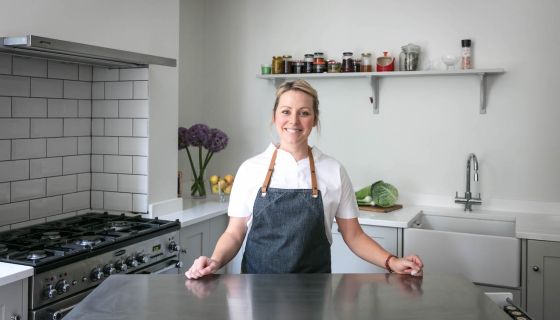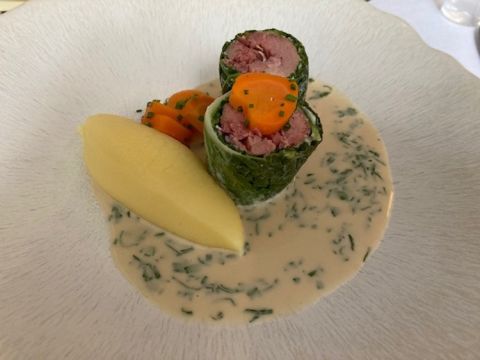It was 3.30 in the afternoon and I was just about to leave Myrtle restaurant, just off the King’s Road in London’s Chelsea, having interviewed its chef/proprietor Anna Haugh, when I witnessed an example of true Irish hospitality in action.
A couple approached and asked whether her restaurant was still open for lunch, before adding that nowhere else they had tried was open that late. ‘Of course’, replied Haugh, ‘come on in’. They were seated and made welcome before ordering two large gin and tonics and, I can only assume, becoming converted to Haugh’s distinctly refined but friendly style of Irish cooking.
Such obvious warmth is the combination of nature and nurture. Haugh was born in Dublin almost 40 years ago and spent her formative years in some of that city’s most renowned restaurants. She gives particular credit to Derry Clarke at L’Ecrivain and Mary McEvoy, then his pastry chef. Family is obviously important to her too – her cousin Daniel is the restaurant manager.
Having moved to London to learn, where she worked initially under Shane Osborne at Pied à Terre and then Philip Howard at The Square, among others, she dreamt of opening her own restaurant. When she first saw this site, abandoned for several years, in 2018 she jumped at it and put all her savings into converting it. ‘It’s my restaurant’, she added emphatically, ‘and that is very important to me and, I hope, to my customers.’
The building is not without its challenges. The kitchen is in the basement, up a steep set of stairs to the tables on the ground floor, and then there is another set that leads to more tables on the first floor. But these challenges, and others, have led Haugh to find sensible solutions.
The first appears on your table after you have ordered, in the form of a brown paper bag of her delicious soda-and-treacle bread alongside a pat of freshly churned butter on a small piece of marble. The bread is not only difficult to resist but comes in an unusual cylindrical shape.
‘It was just before opening’, Haugh explained, ‘and I was about to prepare the first tasting menu when I realised that I didn’t have any baking tins and that I really didn’t have any spare cash. So I used some clean baked-bean tins and when the bread was ready I just sliced it. The marble that we use to serve our butter and our petits fours on was left over from the bar top which my brother-in-law made and then cut up into smaller pieces.’
The menu is determinedly and distinctively Irish. On the left is a tasting menu, with dishes from seven different Irish counties, while the right-hand menu offers à la carte options.
Two of her first courses were exceptional in that they offered a true expression not just of place but also of Haugh’s technique, best described as seemingly simple yet involving a lot of preparation in the kitchen.
The first was a dish of Irish Carlingford oysters, lemon and dill. These plump beauties, briefly washed to remove any grit (‘I hate finding a piece of grit in an oyster’, Haugh explained) are then topped with a three-day marinade of lemon zest and their house vinegar.
The second was a dish of Clonakilty black pudding, which the menu described as ‘wrapped in potato’. So it is, but only after this exceptional black pudding, made from beef rather than pork, is cooked, mixed with a light chicken mousse and egg whites, before being encased in butter and then wrapped in ‘potato spaghetti’. The end result of this two-day process is comfort food of the highest quality.
The main courses present different attractions. There is the smoked-mackerel chowder with the crusted hake; the Dingle pie, a smaller version of a Cornish pasty, with the lamb; and there is the mashed potato and carrot alongside a simple, but apparently hugely popular, dish of bacon rolled in cabbage leaves and served with an unctuous parsley sauce. With all these we enjoyed an extremely well-seasoned dish of colcannon, the Irish combination of mashed potato and cabbage.
Fun, an essential ingredient for Haugh, in fine dining is provided in the desserts. A burnt cream comes up flaming from the kitchen. A chocolate mousse was enlivened by Carrageen moss, a seaweed, and a Guinness sponge. With this we drank a bottle of Chianti Classico 2017 from Isole e Olena (£64) and I paid a bill of £275 for four.
This restaurant is named after the late Myrtle Allen, the determined Irish chef who established via her hotel-restaurant Ballymaloe outside Cork that Irish produce is the equivalent of any other in the world. Haugh fits the physical bill as well as taking over this culinary mantle. Like Allen, she is small, with a smile that could light up any dining room, and is not likely to brook too much in the way of disagreement.
Yet Haugh faces an unusual challenge. Having based her menu on ingredients sourced from the Republic of Ireland – cheese, pork belly, seaweed, flour and smoked fish as well as numerous spirits and even an ice wine from Killahora in County Cork – she is concerned about Brexit. According to Haugh, the associated paperwork has already started arriving. ‘But I am a born optimist’, she adds, ‘and I know we will overcome this.’
Myrtle 1A Langton Street, London SW10 0JL; tel: +44 (0)20 7352 2411














